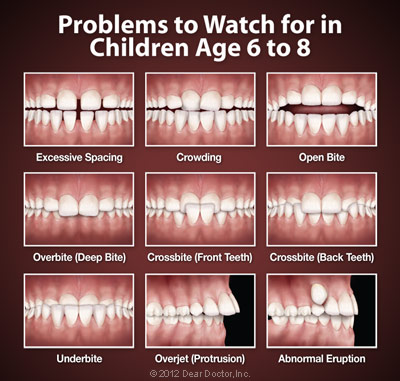We believe that some young patients may benefit from early interceptive orthodontic treatment, including the addressing crossbites, jaw growth problems, space maintenance, and esthetic concerns. Both Dr. Fulmer and Dr. Eakes enjoy seeing patients of all ages.
When is the best time to see an orthodontist?
We are delighted to evaluate children and adults at any age. We especially enjoy getting to know our youngest patients and enjoy the fun they bring to our office! The American Association of Orthodontists recommends an initial orthodontic evaluation for children by the age of 7. There is an optimal time period to begin treatment that gives us an opportunity to get the best results in the least amount of time and expense. If a child does not yet need orthodontic treatment at the time of evaluation, we often recommend periodic observation visits to monitor growth, dental development, and orthodontic needs to anticipate the best time to begin treatment.
Why should my child be evaluated by age 7?
Although every child's development is different, in most kids the permanent first molars have started to emerge by around age 6. By age 7, the bite on the back teeth is usually established. We can evaluate the relationships of the teeth in the front and the back as well as assess the jaw growth pattern. It may also be possible at this point to determine whether there is adequate room in the mouth for all of the permanent teeth — and, if not, to take action or monitor things for a while.
What are the benefits of early orthodontic evaluation?
Early evaluation can allow us to detect and treat problems early, preventing serious problems later that can sometimes require more involved treatment. Treatment for common orthodontic problems typically begins around age 9-14, when all of the baby teeth have been lost and many of the permanent teeth are in place. However, there are some conditions that are much easier to treat if they are caught at an early age.

What are some problems that early treatment can address?
Some of the reasons we may recommend early treatment, sometimes called a "first phase of treatment" include:
- Creating room for crowded teeth that cannot erupt from under the gum tissue
- Correcting crossbites of the front and/or back teeth
- Reducing the chance of needing permanent tooth removal with expanders or braces.
- Improving facial harmony by influencing jaw growth
- Reducing the risk of trauma to protruding front teeth
- Preserving space for unerupted permanent teeth
- Helping a child stop a thumb, digit, or tongue thrust habit that is contributing to bite, jaw growth, and/or speech problems
- Improving a child’s self-esteem by improving tooth alignment
- Reducing treatment time and complexity with full braces when the patient is older or even making a second phase of orthodontics elective